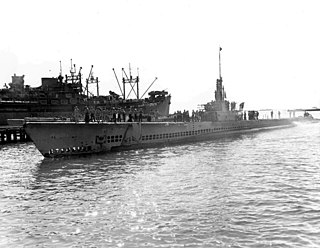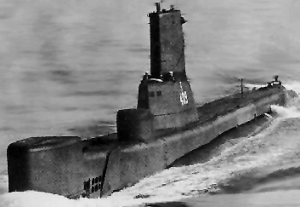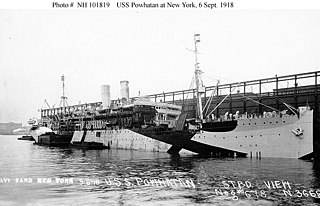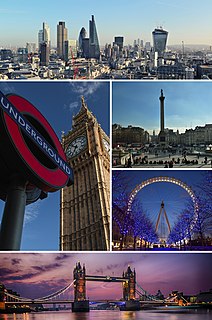
A submarine-launched ballistic missile (SLBM) is a ballistic missile capable of being launched from submarines. Modern variants usually deliver multiple independently targetable reentry vehicles (MIRVs) each of which carries a nuclear warhead and allows a single launched missile to strike several targets. Submarine-launched ballistic missiles operate in a different way from submarine-launched cruise missiles.

Holland America Line is a British/American-owned cruise line, a subsidiary of Carnival Corporation & plc. Originating in the Netherlands, the company moved its headquarters to Seattle, Washington, United States.

USS O-9 (SS-70) was an O-class submarine of the United States Navy. Her keel was laid down on 15 February 1917 at Fore River Shipbuilding Company of Quincy, Massachusetts. She was launched on 27 January 1918 sponsored by Mrs. Frederick J. Sherman, and commissioned on 27 July 1918 with Lieutenant Oliver M. Read, Jr. in command.

The New York Shipbuilding Corporation was an American shipbuilding company that operated from 1899 to 1968, ultimately completing more than 500 vessels for the U.S. Navy, the United States Merchant Marine, the United States Coast Guard, and other maritime concerns. At its peak during World War II, NYSB was the largest and most productive shipyard in the world. Its best-known vessels include the destroyer USS Reuben James (DD-245), the cruiser USS Indianapolis (CA-35), the aircraft carrier USS Kitty Hawk (CV-63), the nuclear-powered cargo ship NS Savannah, and a quartet of cargo-passenger liners nicknamed the Four Aces.

USS Lionfish (SS-298), a Balao-class submarine, was the only ship of the United States Navy named for the lionfish, a scorpaenid fish native to the Pacific and an invasive species found around the Caribbean. She was designated a National Historic Landmark in 1986, and is now on display at Battleship Cove in Fall River, Massachusetts.
HMS Western Isles was a command ship of the Royal Navy during World War II, serving as the flagship of the Anti-Submarine Training School at Tobermory on the Isle of Mull under Vice Admiral Gilbert Stephenson. Launched in 1902 as the Dutch Batavier Line passenger ship Batavier IV, after the war she served in the Royal Netherlands Navy as the training ship Hr. Ms. Zeearend . She was decommissioned in 1970, and scrapped in 1972.

USS Burrfish (SS/SSR-312) was a Balao-class submarine of the United States Navy named for the burrfish, a swellfish of the Atlantic coast. The vessel entered service in 1943 and saw action during World War II and in the postwar era. In 1961 Burrfish was loaned to the Royal Canadian Navy where she served as HMCS Grilse and was used primarily as a training boat from 1961 until 1969.

USS Becuna (SS/AGSS-319), a Balao-class submarine, is a former ship of the United States Navy named for the becuna, a pike-like fish of Europe. She was designated a National Historic Landmark for her service in World War II, for which she earned four battle stars. She presently serves as a museum ship at the Independence Seaport Museum in Philadelphia, Pennsylvania.

The United States' S-class submarines, often simply called S-boats, were the first class of submarines with a significant number built to United States Navy designs. Others of this class were built to contractor designs.

USS Piper (SS/AGSS-409), a Balao-class submarine, was a ship of the United States Navy named after the piper.

USS O-6 (SS-67) was an O-class submarine of the United States Navy which served in both world wars.

USS O-10 (SS-71) was an O-class submarine of the United States Navy. Her keel was laid down on 27 February 1917 by the Fore River Shipbuilding Company in Quincy, Massachusetts. She was launched on 21 February 1918 sponsored by Mrs. John E. Bailey, and commissioned on 17 August 1918 with Lieutenant Sherwood Picking in command.

The fifth SS Rotterdam, also known as "The Grande Dame", is a former ocean liner and cruise ship, and has been a hotel ship in Rotterdam, the Netherlands, since 2010. She was launched by Queen Juliana of the Netherlands in a gala ceremony on 13 September 1958, and was completed the following summer. The Rotterdam was the last great Dutch "ship of state", employing the finest artisans from the Netherlands in her construction and fitting out process. Her career spanned forty-one years. She sailed from 1959 until her final retirement in September 2000.

USS Powhatan (ID–3013) was a transport ship for the United States Navy during World War I. She was originally the SS Hamburg, a Barbarossa-class ocean liner built in 1899 by Aktiengesellschaft Vulkan of Stettin, Germany, for the Hamburg America Line. At the outset of World War I the ship was interned by the United States.

SM UB-6 was a German Type UB I submarine or U-boat in the German Imperial Navy during World War I. The submarine was interned after running aground in neutral Dutch waters, and was scuttled by her crew at Hellevoetsluis.
SS Batavier V may refer to one of the following ships of the Batavier Line:

SS Batavier V was a steam packet for the Batavier Line that sailed between Rotterdam and London for most of her career. The ship was built in 1897 by the Gourlay Brothers of Dundee. The Dutch ship could carry a limited amount of freight and up to 428 passengers. She was rebuilt in 1909 which increased her length by over 5 metres (16 ft).

SS Volendam was a 15,434 GRT ton ocean liner operated by Holland America Line. She was built in 1922 by Harland & Wolff Ltd, in Govan, Glasgow. Her 15,450 GRT sister ship TSS Veendam was built by Harland & Wolff the following year. She operated on transatlantic routes between Europe and the USA, sailing the Rotterdam – New York and Rotterdam – Halifax service.


















